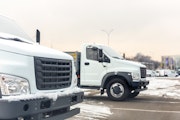Navigating fleet management: A buyers guide
Learn what's important when evaluating your options for fleet management software solutions.
Read more
Picture this: one of your drivers is behind on a delivery deadline. They look down at their phone to check the route and then start rushing just a few miles over the speed limit to try and make up time, making a rolling stop at a stop sign. This single incident might not seem like a big deal, but collectively these unsafe driving behaviors can have a serious impact on your business, bottom line and reputation.
As a fleet manager, you know how hard it is to get a complete sense of what your drivers and vehicles are experiencing on the roads. Using the right technology enables you to make safety your top priority while ultimately helping to level-up operations at every level.
A fleet management system gives you the tools you need to closely monitor driver behavior, identify any fleet safety risks and help prevent accidents before they happen. The latest fleet management system capabilities are changing the way fleets make operational decisions to bring safety to the forefront.
Let’s go through some of the common questions you might have when selecting a fleet management system. The right solution — particularly one that integrates smart AI dashcams — can help you improve fleet safety, protect your drivers and keep your business moving forward.
According to the Fleet Technology Trends Report, fleet companies using GPS Fleet Tracking saw a 19% reduction in average accident costs and 11% decrease in average insurance premium costs.1
A fleet management system includes a GPS tracking device installed in a vehicle, providing near-real time insights into vehicle data and driver behavior. This can include location, speed, idling time, harsh acceleration or braking, fuel consumption, vehicle faults, engine data and more. When analyzed for events and patterns, this information can provide insights across your entire fleet.
A fleet management system offers continuous feedback on driver behavior so fleet managers can coach drivers on how to reduce unwanted driving habits like speeding or harsh braking. Improvements can then be made based on actionable, data-based reports that highlight driver performance and support fleet safety targets.
Here are the results2: fleets have seen using Verizon Connect’s AI dashcams with in-cab alerts significantly improve driver behavior, leading to a substantial reduction in safety-critical events.
Fleets who have actively used the reporting and alert features saw significant improvement2 in behaviors and driving practices:
Like vehicle tracking, asset tracking can help you streamline managing and monitoring your powered and non-powered equipment with near real-time usage data. You can easily locate your physical assets on a live map alongside your vehicles and receive metrics into how often they’re used and by whom.
Powered and non-powered assets are often one of the top expenses for many businesses. To get more out of that investment, modern asset tracking streamlines the critical data from all assets into one centralized location. It also helps to improve asset longevity, security and utilization.
Some common types of business assets that your fleet management system can track are:
Forward-facing cameras help fleet managers mitigate on-the-road risks, while driver-facing cameras are effective in monitoring driver behavior, given they provide an internal view of the cab and front seat. Options include dual-facing dashcams that offer a single road-facing camera with a driver-facing attachment.
Additionally, with extended view cameras, you get:
Additional camera add-ons are also available, including rear, side and cargo cameras.
Survey respondents reported in-cab video technology helped them improve driver safety by 74% this year.3
Adding a video component, like a dashcam, completes the overall picture within your fleet management system. You can even schedule a professional installer to come out and install the system for you. The hardware should be mounted on the inside of the windshield in an area that won’t obstruct the driver’s view, behind the rearview mirror on most vehicles.
Video clips from harsh driving events seamlessly upload into Verizon Connect Reveal, reducing the need to log into multiple sites. You can then learn from the aggregate of data from telematics and dual video footage supported by AI.
74% of respondents used video to achieve their goal of improving driver safety.4
It’s common to hear objections about technology that collects data or tracks movement, but smart technology can increase trust within your organization if implemented and messaged correctly.
Suspicion from drivers and employees is often made worse by a lack of information, so take every opportunity to establish trust and cooperation from the start by providing access to live demos and having candid conversations about the benefits of video technology.
You’ll be in good company once you implement AI dashcams and your drivers get on board with the solution. 38% of fleets with 1-49 vehicles are already utilizing in-cab video, including driver- and front-facing cameras.5
Reliability can be a big concern for fleet managers, but modern fleet management systems are built to minimize the risks if a vehicle enters a dead zone, or the system experiences a temporary outage. Even if cellular coverage drops, many units can store data locally and automatically sync once a signal is restored.
The value of a fleet management system goes beyond the hardware and software — it’s also about having access to support that keeps your operation running smoothly. To help you save time, Verizon Connect offers various support options that don’t require you to contact customer service. You can:
When looking at a video telematics solution, look for these features:
It can be easy to feel overwhelmed when every vehicle and driver generates alerts and reports. That’s why modern fleet management systems include smart strategies for managing notifications and features — so you see only what’s most important to you.
When the AI dashcam detects risky behavior from a driver, an in-cab audio alert will immediately tell the driver what they did, and video footage of the event is uploaded to the platform.
Here’s how it works on your end:
AI-based video analytics filters out inconsequential events and classifies events, with the option to customize alerts when an incident occurs involving a vehicle or driver. The right fleet management system features will save you valuable time by applying these AI algorithms to analyze every video, classifying them by type of event/severity level (e.g., harsh driving event, tailgating, distracted driving, etc.). You don’t want to have to sort through hours of video, resulting in little to review or take action on unless notified by the system.
Fleet safety isn’t something you can leave to chance. A reliable fleet management system helps overcome information overload and delivers meaningful monitoring features — from real-time alerts to detailed reporting. Just as important, strong customer support and an intuitive interface ensure the system works for you, not against you.
When evaluating options, it’s important to focus on solutions that prioritize fleet safety, simplicity and support. Verizon Connect is committed to helping you create a safer tomorrow by empowering your fleet with technology that helps you connect, coach and champion safe driving behavior.
1,3,4,5 Fleet Technology Trends Report
2 Reveal aggregated customer data, North America, 2024.
Tags: Safety




Find out how our platform gives you the visibility you need to get more done.
Learn what's important when evaluating your options for fleet management software solutions.
Read moreAt Verizon Connect, we deliver fleet safety solutions including AI dash cams, driver vehicle-inspection reporting and...
Read moreLearn about video enhancements, metrics, and other features that can improve fleet management...
Read moreGet a jumpstart on choosing an asset management solution with this buyers guide. It includes questions to consider, attributes...
Read more